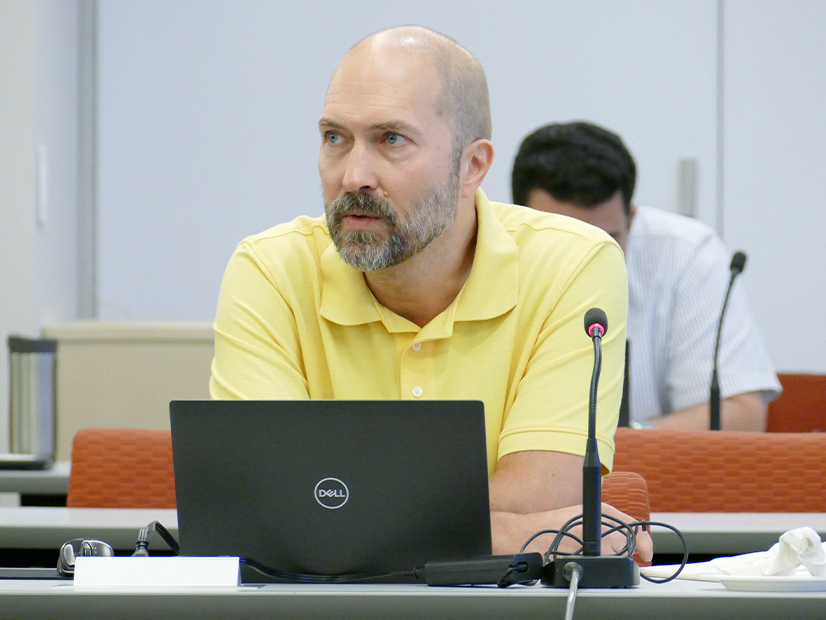The PJM Planning Committee on Jan. 10 endorsed a proposed solution for capacity accreditation of intermittent resources under the effective load-carrying capability process.
Out of the five proposals before the committee, PJM’s Package I received 82.4% of stakeholders’ support. The proposal’s central feature is a transitional mechanism to allow resources seeking higher capacity interconnection rights (CIRs) to temporarily receive a higher capacity rating. (See PJM Stakeholders Review Proposals on CIRs for ELCC Resources.)
Only Package I cleared the 50% support threshold to advance to the Markets and Reliability Committee. PJM’s Package D received the next highest degree of support, with 34.9%. LS Power’s Packages K and E received 29.3% and 24.1% support, respectively, while Package G from E-Cubed Policy Associates was endorsed by only 7.1%.
How to define existing resources’ capacity rating until a permanent solution can be implemented remained the main sticking point throughout the PC’s discussions of the issue. Most of the proposals, including Package I, would require resources seeking a higher accreditation to re-enter PJM’s interconnection process at the end of the queue, which has been mired in a backlog spanning years.
Package I would also allow resources to utilize existing headroom on the transmission system through a transitional system capability study, though it would also cap the actual accreditation at the facility’s existing CIR. That headroom would be available so long as it is not claimed by another resource’s CIRs and until PJM has completed the process of transitioning to its new methodology of studying interconnection requests.
To be eligible to participate in a transitional study, the additional capacity must be deliverable without any physical modifications made to the generation resource, and an uprate request must be submitted to PJM.
During a special MRC meeting to “page turn” the proposal Friday, PJM’s Jonathan Kern said the RTO’s goal is to open a 30-day window for submitting uprate requests that would close on March 3.
Stakeholders noted that if the proposal was to be approved by the MRC and the timeline implemented, the window would be opening prior to FERC approval of the changes. Kern said the timing is envisioned to allow PJM to jump on implementation following a prospective commission approval and have everything ready to be included in the 2025/26 Base Residual Auction (BRA) scheduled in June.
“One of the primary goals here is to accomplish all of this in time for the 2025/26 BRA,” he said, noting that the target was part of the package approved by the PC. “We’re committed to making this happen, and this 30-day window is essential, PJM believes, to make this goal.”
The second-highest vote getter, Package D, was the only proposal that would have granted higher CIRs outside of the interconnection process. New deliverability tests would been conducted and been the basis for granting the higher CIRs for existing wind and solar resources starting with the 2023 Regional Transmission Expansion Plan. It was also the only proposal that would have allocated the cost of any transmission upgrades necessary to accommodate the higher capacity ratings to load rather than the generators.
LS Power’s Package K was built off PJM’s prevailing proposal but included a request that the RTO’s Board of Managers direct staff to submit a filing with FERC clarifying that the Reliability Assurance Agreement establishes CIRs as the hourly upper limit for unforced capacity accreditation starting with the 2025/26 BRA.
The company’s other proposal would have immediately limited accreditation to a generator’s CIR level and required those seeking higher accreditation to re-enter the interconnection process at the end of the queue.
While Package E received the highest share of support in an October poll at the PC, PJM overhauled its Package I to include the transition studies and later expanded eligibility to all resources; originally only intermittent generation would have been permitted to utilize the existing headroom.
Package G would have also required resources to re-enter the transmission queue to receive higher accreditation, while also expanding deliverability testing into the shoulder months to capture increasing reliability concerns being seen in those seasons.

